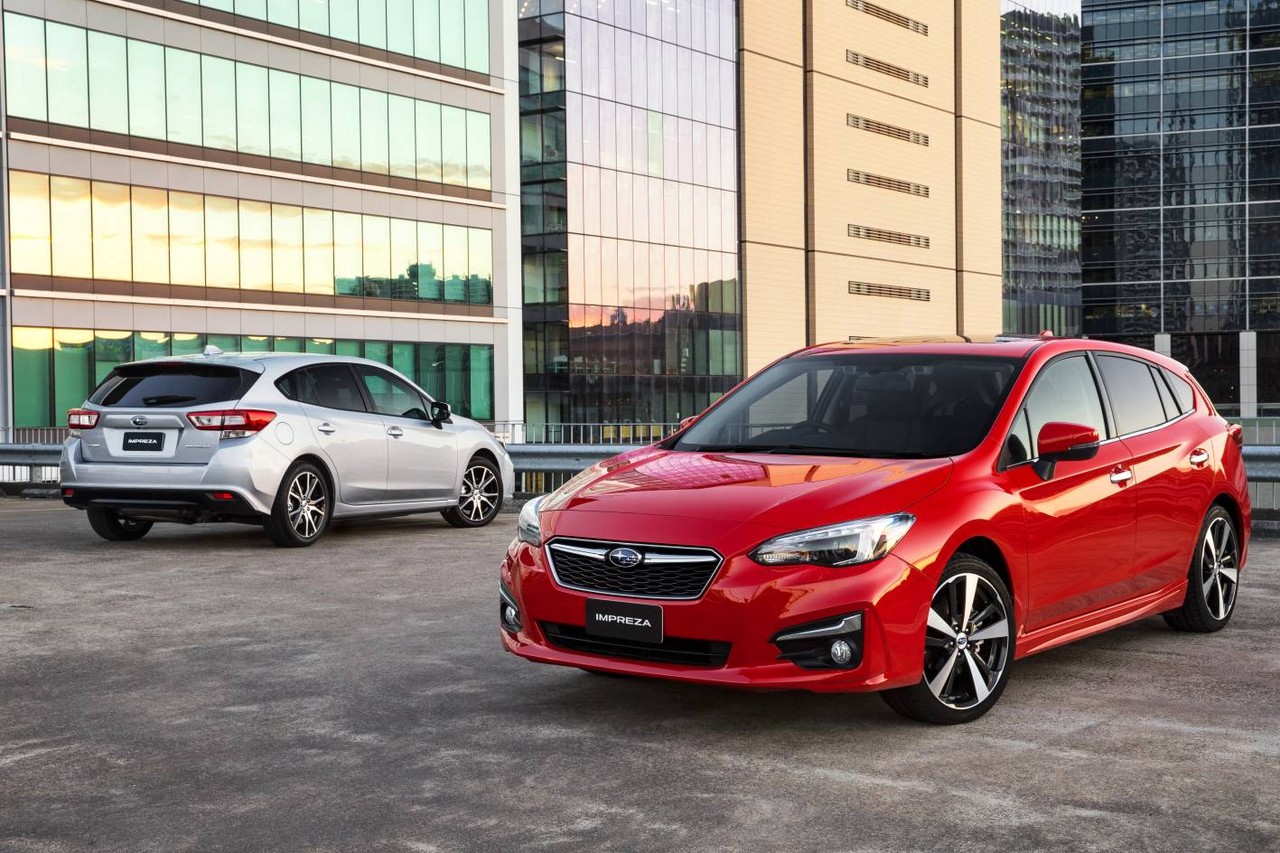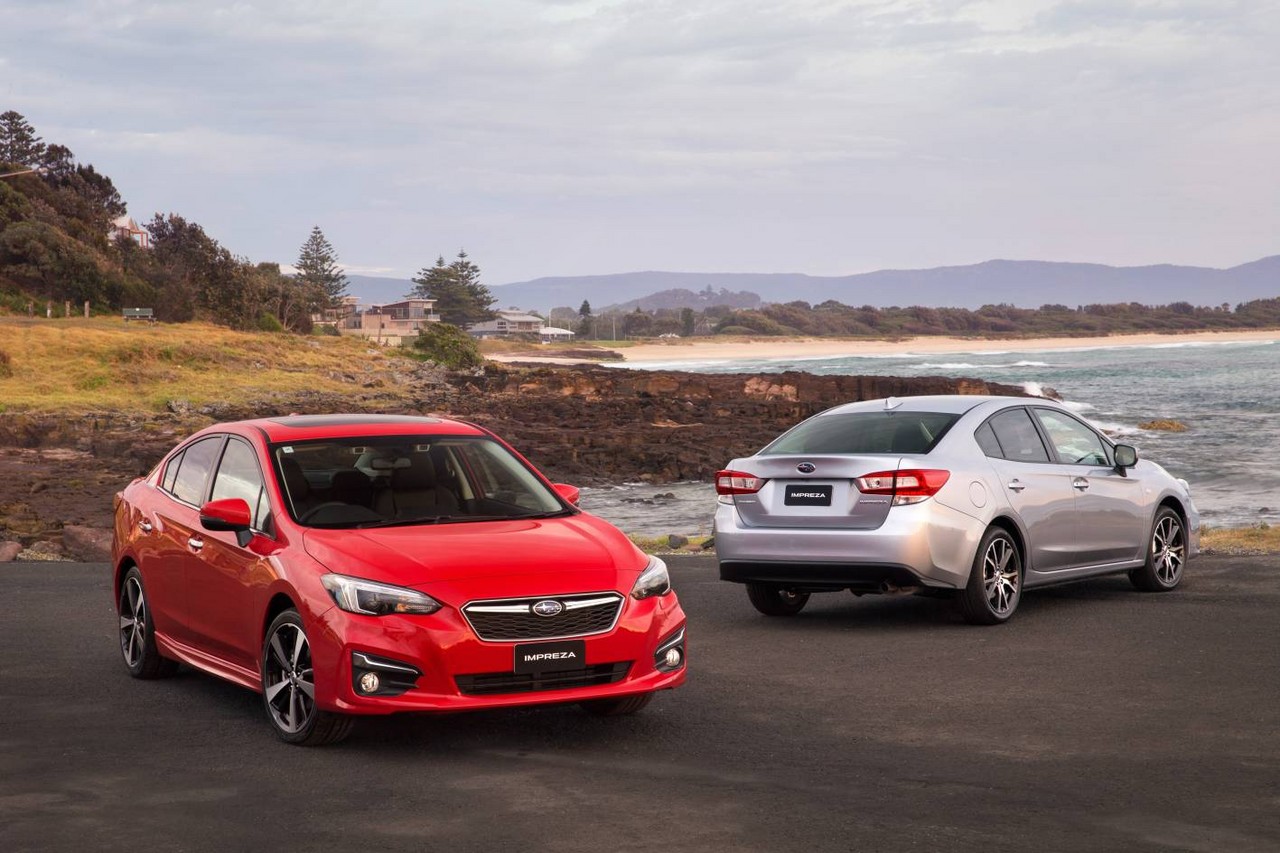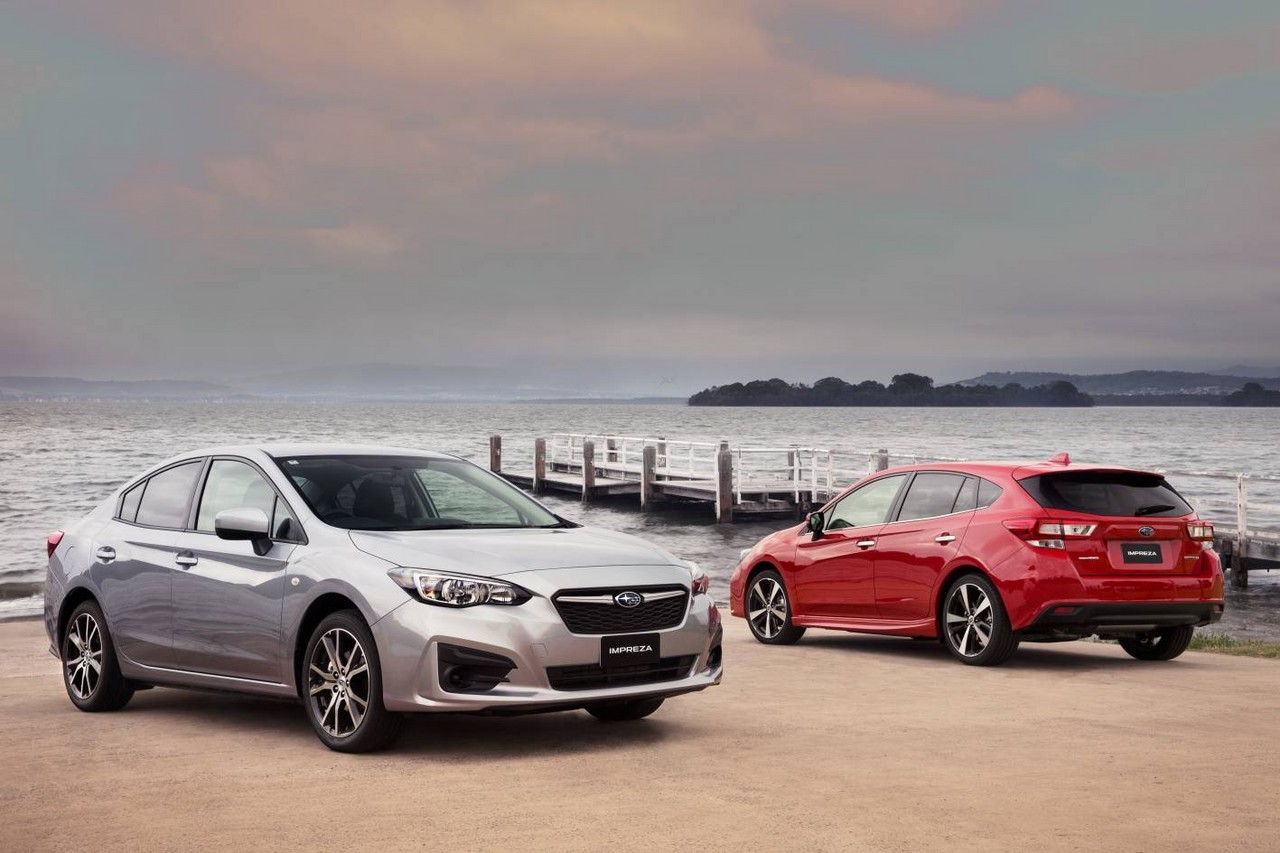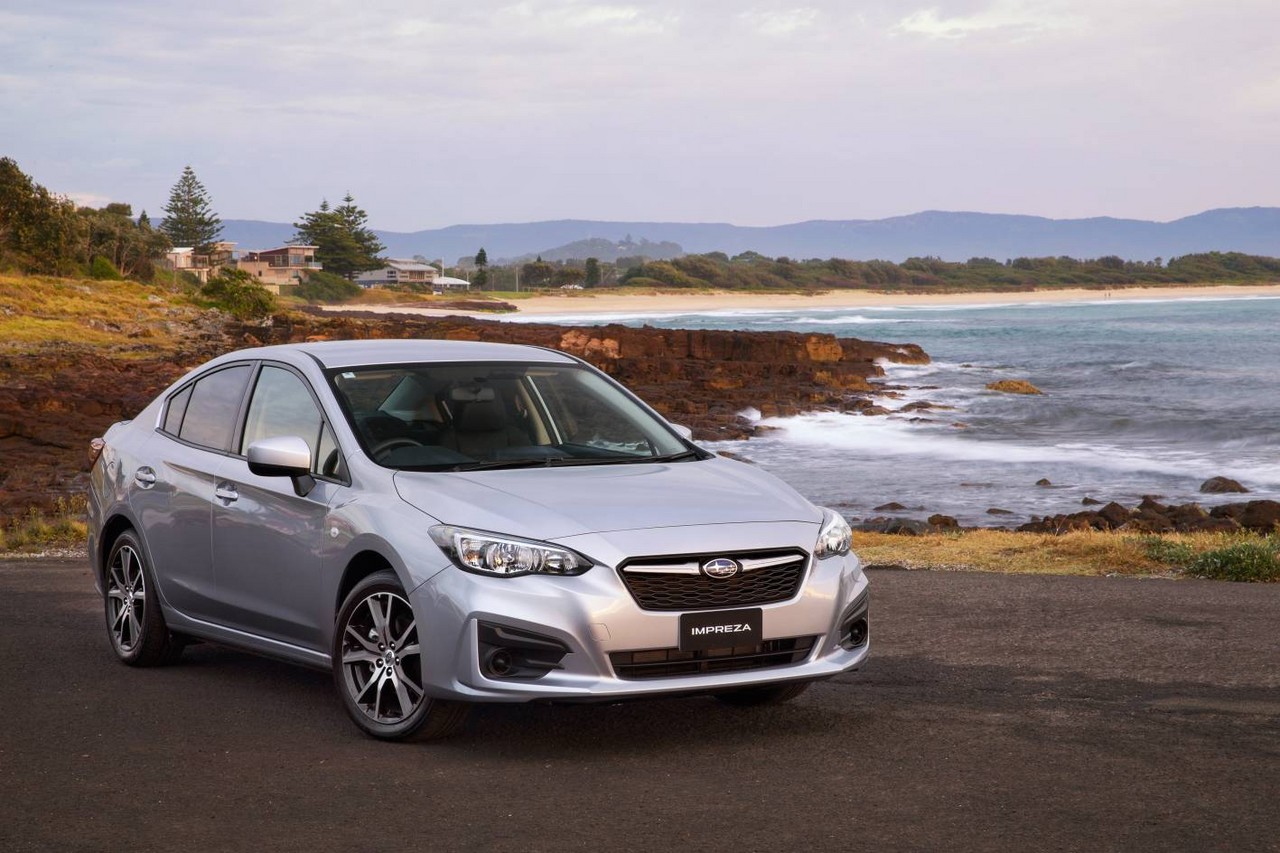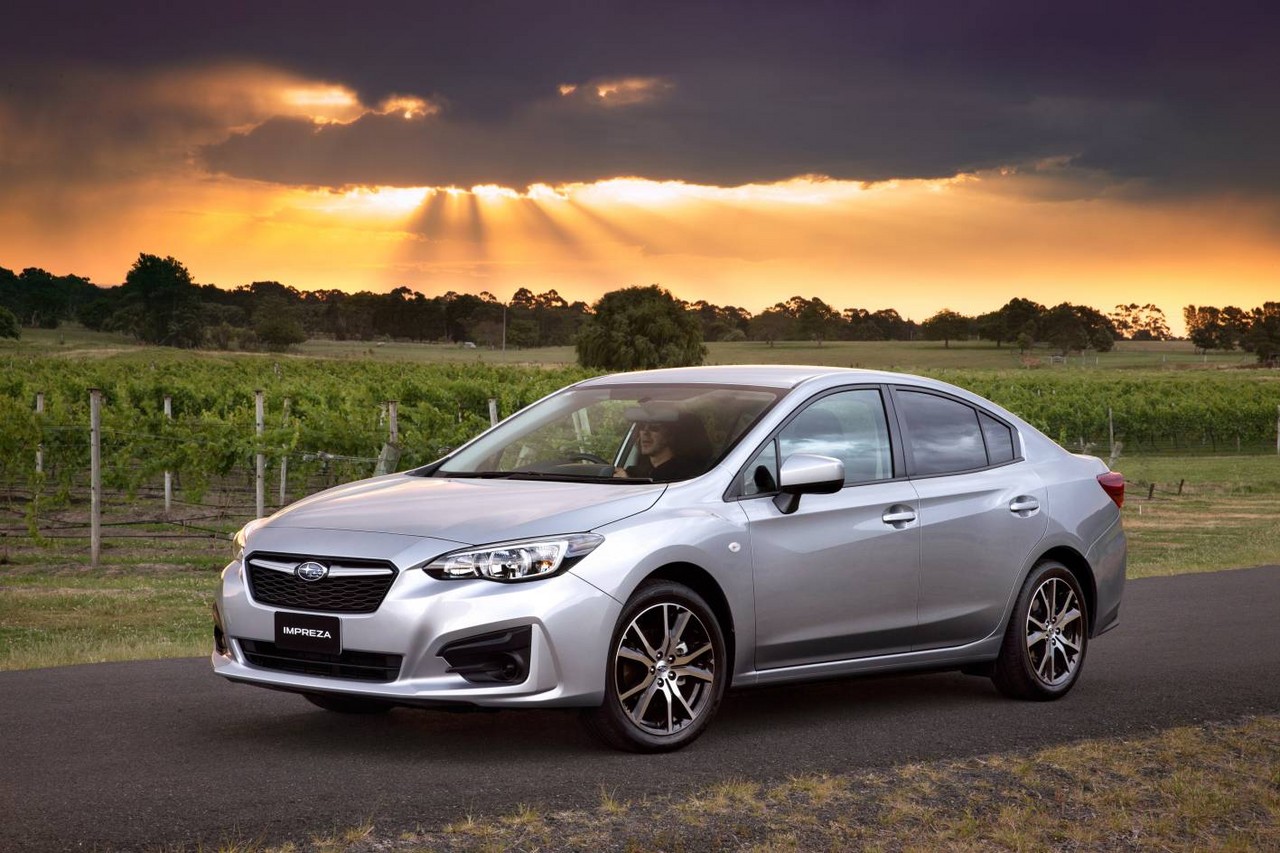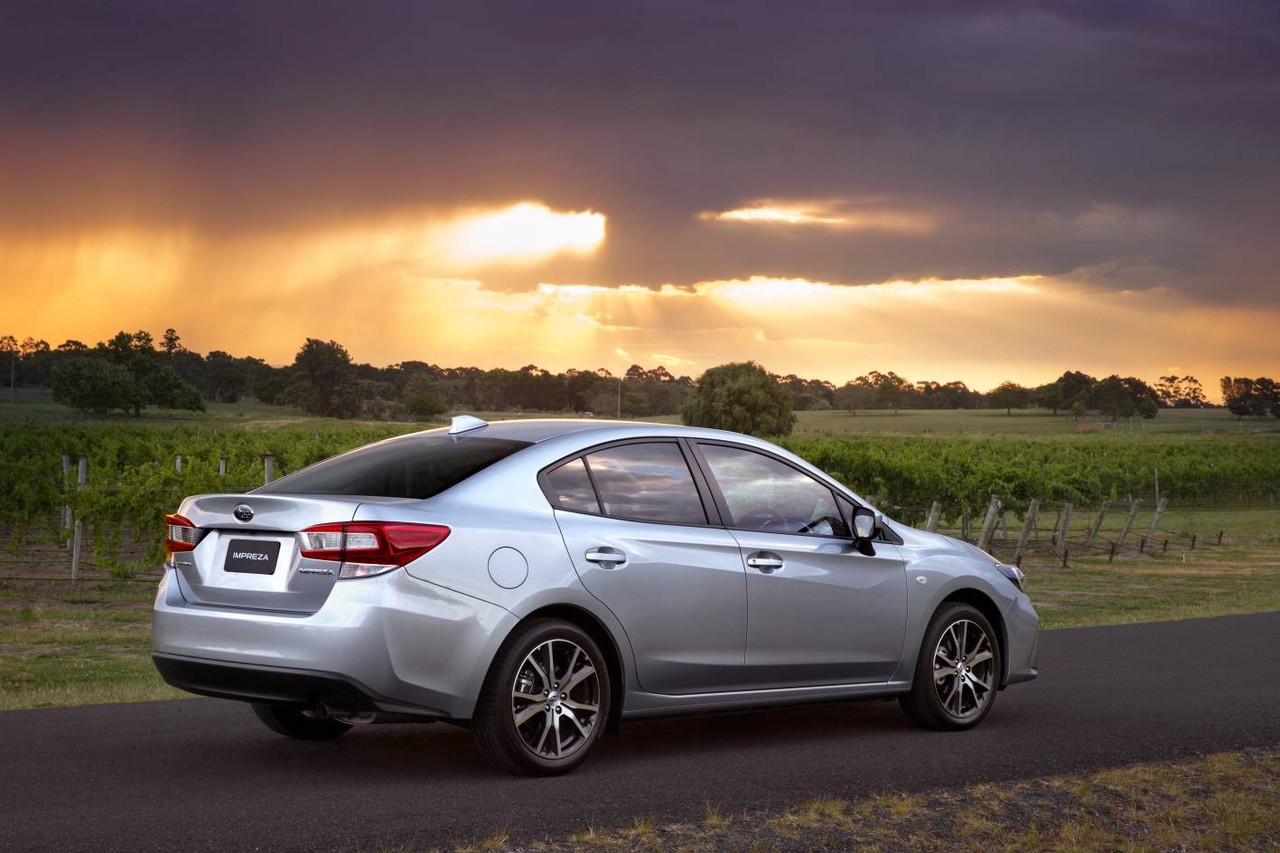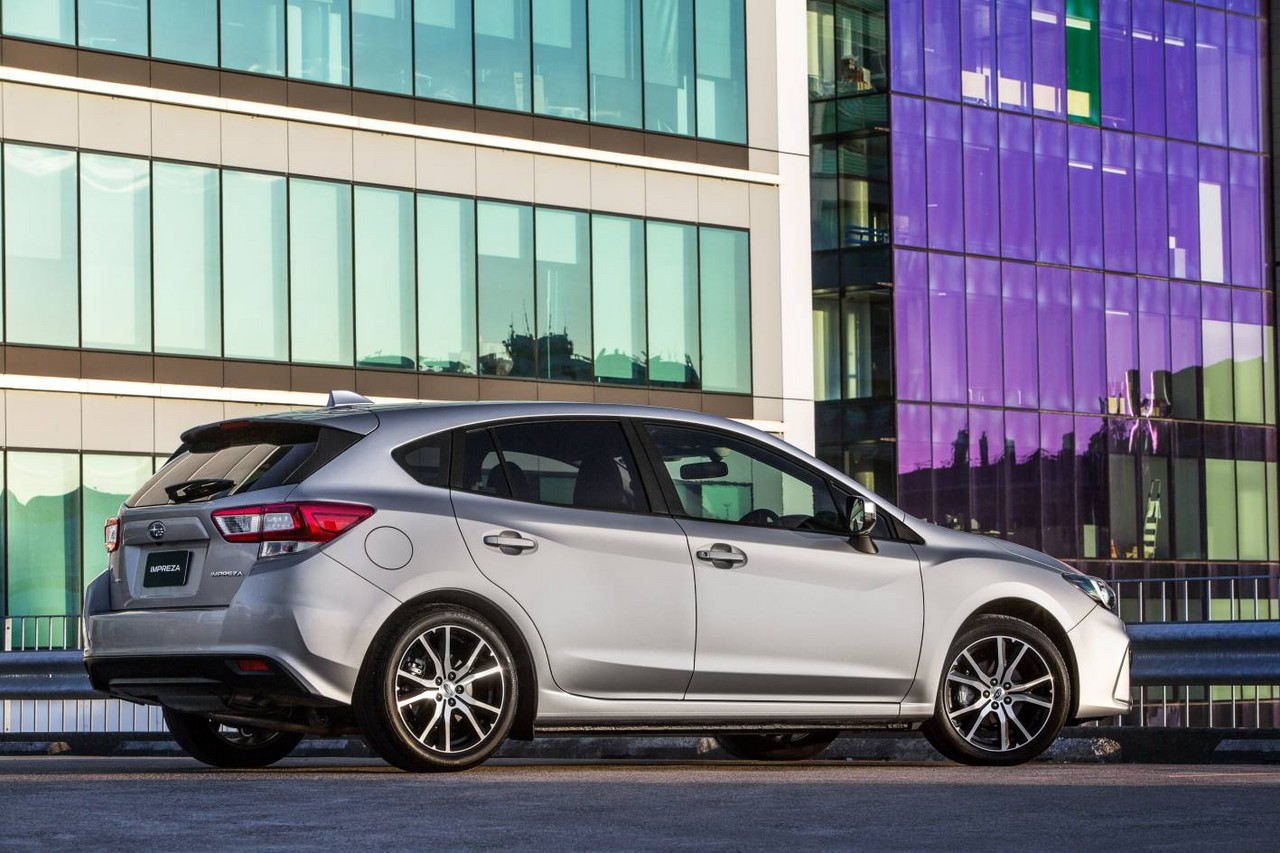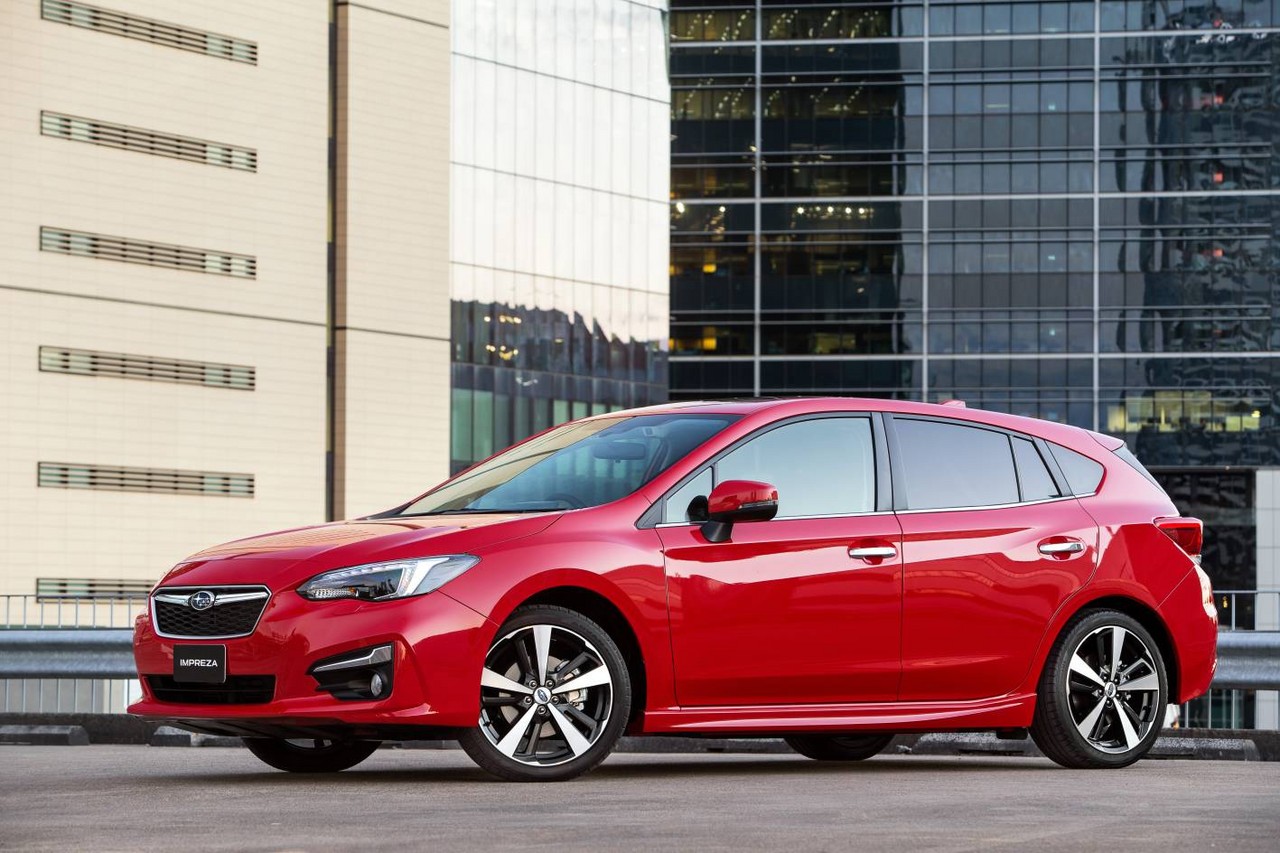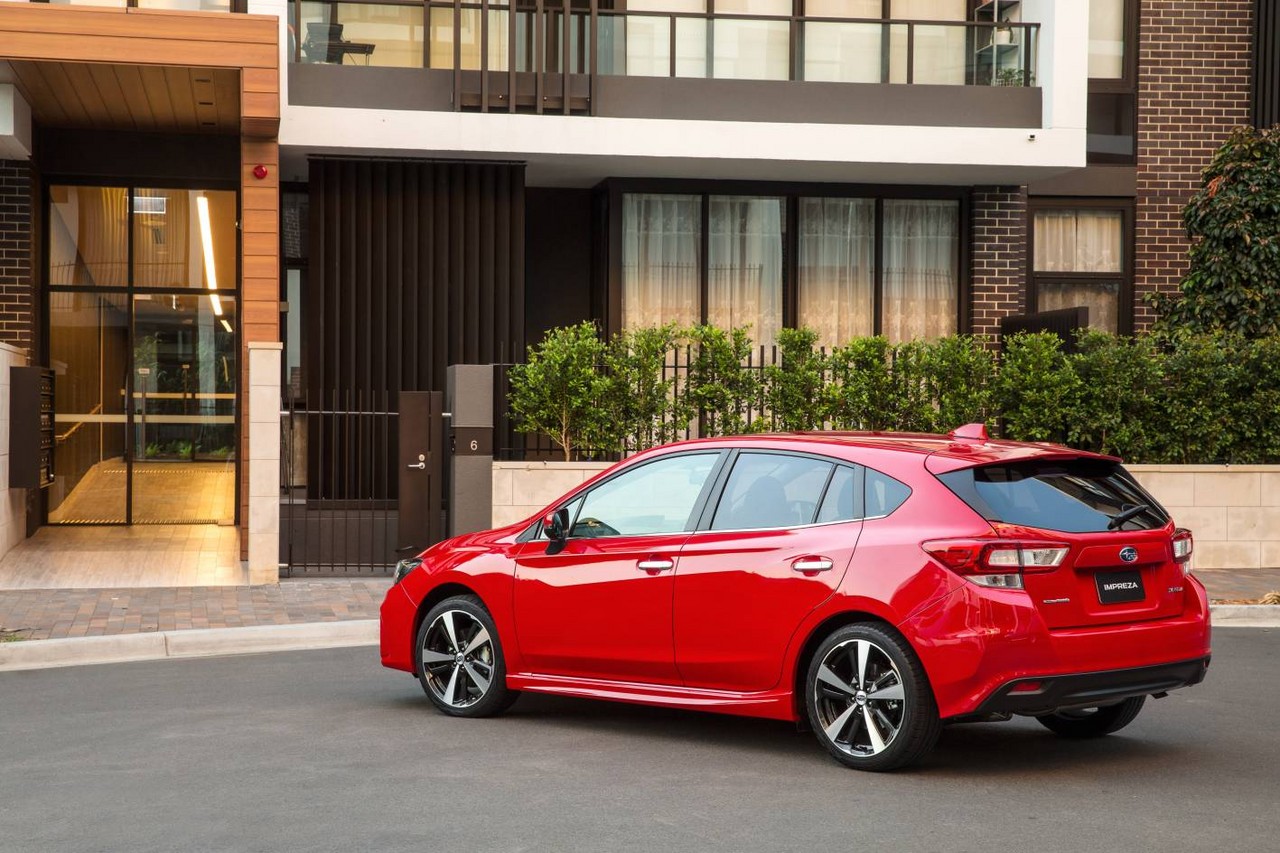
- Impressive ride/handling balance with Active Torque Split AWD system
- Well-weighted steering
- High standard of interior fit and finish
- Good ergonomics
- Availability of autonomous emergency braking…
- … but not standard for Impreza 2.0i
- CVT droning noise and, at higher engine speeds, whining noise
- Engine lacks low-rev torque of some rivals
- No manual transmission option
- Sunroof reduces headroom for Impreza 2.0i Premium and 2.0i-S
Overview
Released in Australia in December 2016, the fifth-generation Subaru Impreza range consisted of the GK Impreza sedan and the GT Impreza hatch. Manufactured in Ota, Japan, the all-wheel drive Subaru GK/GT Impreza was powered by a 2.0-litre FB20 petrol engine that was mated to either a six-speed manual or continuously variable transmission (CVT).
FB20 engine and ‘Lineartronic’ CVT
The Subaru GK/GT Impreza was powered by Subaru’s 2.0-litre horizontally-opposed (or ‘boxer’) FB20 petrol engine which had an open-deck aluminium alloy cylinder block, an aluminium alloy cylinder head, double overhead camshafts, four valves per cylinder, variable intake and exhaust valve timing (Subaru’s ‘Dual Active Valve Control System’), direct petrol injection and a compression ratio of 12.5:1. For the fifth-generation Impreza, Subaru claimed that 80 per cent of the FB20 engine ‘s components were revised, with changes including:
- a more rigid cylinder block for a higher compression ratio;
- a lighter crankshaft and connecting rods;
- a molybdenum coating for all crankshaft bearings to reduce friction;
- cast journal pieces for the #1 and #5 journals;
- re-shaped intake ports, a revised tumble generation valve and port internal baffle to increase the tumble motion of the intake air;
- conical shape valve springs (previously cylindrical);
- sodium-filled exhaust valves for heat dissipation;
- for the pistons, a new crown shape and high thermal-conducting type top piston ring;
- a re-shaped head gasket;
- a water jacket spacer to reduce friction caused by the higher liner surface temperature; and,
- a high-flow exhaust gas recirculation (EGR) system and cooler.
To reduce fuel consumption, the FB20 engine had an ‘Auto Start Stop’ system which enabled it to shut down when the vehicle was stationary in traffic to reduce fuel consumption. For the Impreza 2.0i, 2.0i-L and 2.0i Premium, fuel consumption over the combined ADR 81/02 test cycle was 6.6 litres per 100 km; for the Impreza 2.0i-S, fuel consumption was 7.2 litres per 100 km.
The Subaru GK/GT Impreza was available with a six-speed manual transmission or a ‘Lineartronic’ continuously variable transmission (CVT) which featured a seven-speed manual mode function. According to Subaru, both noise and vibration for the engine and transmission were ‘greatly reduced’.
| Variant | Engine | Trans. | Peak power | Peak torque |
|---|---|---|---|---|
| 2.0i, 2.0i-L, 2.0i Premium, 2.0i-S |
1995 cc FB20 petrol I4 | CVT | 115 kW at 6000 rpm | 196 Nm at 4000 rpm |
Active Toque Split AWD system
For Subaru GK/GT Impreza models with the CVT, the all-wheel drive system utilised an electronically-controlled multi-plate transfer clutch (Subaru’s ‘Active Torque Split’ system). The system provides a default front:rear torque split of 60:40 in normal conditions, though additional torque could be sent to the rear wheels if slip is detected at the front wheels.
The Subaru Impreza 2.0i-S also had an Active Torque Vectoring System which could reduce understeer by applying brake pressure to the inside front wheel when cornering.
Body and dimensions
The fifth-generation Impreza was underpinned by the new ‘Subaru Global Platform’ which achieved an increase in torsional rigidity of 70 per cent due to:
- The increased use of high-strength steels (9 per cent 1470 MPa steel and 57 per cent 440 MPa steel compared to 1 per cent and 45 per cent, respectively, for the GP/GJ Impreza);
- An ‘optimised frame structure’; and,
- Stronger joins between parts.
Compared to the Subaru GP Impreza sedan , the GK Impreza sedan is 45 mm longer (at 4625 mm), 35 mm wider (1775 mm, excluding door mirrors), 10 mm lower (1455 mm) and has a 25 mm longer wheelbase (2670 mm). The Subaru GT Impreza hatchback is 4460 mm long and 1480 mm tall, but has the same width and wheelbase length as the GK Impreza sedan. Kerb weight for GK/GT Impreza ranged from 1386 kg (Impreza 2.0i sedan) to 1438 kg (Impreza 2.0i-S hatch).
The Subaru GK Impreza sedan had a boot capacity of 460 litres. Luggage capacity for the GT Impreza hatch was 345 litres beneath the cargo cover, though this increased to 795 litres when the rear seats were folded down.
Suspension and steering
The fifth-generation Subaru Impreza had MacPherson strut front suspension with lower L-arms, coil springs and a stabiliser. Furthermore, the Impreza had double wishbone rear suspension with coil springs and a stabiliser bar. According to Subaru, mounting the rear stabiliser bar directly to the body reduced body roll by 50 per cent relative to the Subaru GP/GJ Impreza .
The Subaru GK/GT Impreza had rack-and-pinion steering with electric power assistance; the steering gear ratio was 13.0:1, while the minimum turning circle was 10.6 metres.
Safety equipment
Standard safety equipment for the Subaru GK/GT Impreza included dual front airbags, a driver’s knee airbag, front side airbags, full-length curtain airbags (i.e. for front and rear occupants), ABS, electronic brake force distribution, brake assist, electronic stability control, traction control and front seatbelts with pre-tensioners and load limiters.
The Impreza 2.0i-L, 2.0i Premium and 2.0i-S were further equipped with Subaru’s EyeSight Driver Assist’ system which used a third-generation CMOS (complementary metal-oxide semi-conductor) camera and included the following technologies –
- Adaptive Cruise Control (ACC): could maintain a safe distance from the vehicle ahead by braking, or accelerate up to the driver-selected target speed where safe to do so. ACC could operate at speeds up to 145 km/h and could detect illumination of the brake lights of the vehicle ahead for smoother deceleration and acceleration;
- Lane Departure Warning: could detect if the car began to drift outside its lane and issue a warning;
- Lane-sway warning: at speeds above 60 km/h, vehicle sway (or drift) was monitored and, if detected, a warning message and tone was issued. Vehicle sway could result from driver fatigue, inattentive driving or cross-winds;
- Lead Vehicle Start Alert: if an obstacle was detected in front of the vehicle, sudden movement or unintended depression of the accelerator would be restricted. A warning display and sound would also be activated;
- Pre-Collision Braking Assist: could prime the braking system for more rapid deceleration when the brake pedal was depressed or autonomous braking activated;
- Pre-Collision Braking: monitored the distance to objects ahead could detect if a collision was imminent, provided the relative speed difference of the vehicle ahead was less than 50 km/h . If detected, the brakes would be applied to avoid or minimise the severity of the collision (also known as ‘Autonomous Emergency Braking’, or AEB);
- Pre-collision throttle management: where there was a risk of collision with the vehicle ahead, pre-collision throttle management would reduce available acceleration;
- Pre-Collision Steering Assist: if there was a possibility of colliding with a car or object in front and the driver used the steering wheel to take evasive action, Pre-Collision Steering Assist could alter the stability control settings to assist the driver to avoid the collision; and,
- Brake light recognition: could detect if the brake lights of the vehicle ahead were illuminated – this could provide earlier detection of a collision hazard.
The Impreza 2.0i-S was also equipped with Subaru’s ‘Vision Assist’ safety technologies which included:
- Blind Spot Detection (BSD): could detect if another vehicle was in the driver’s blind spot and, if so, illuminated an icon in the door mirror. If the driver then applied the indicators to change into that lane, the icon would flash to warn the driver;
- Lane Change Assist (LCA): could detect if a vehicle in an adjacent lane was approaching from behind and would flash the icon in the door mirror on that side of the Levorg to warn the driver; and,
- Rear Cross Traffic Alert: could detect oncoming vehicles that may cross the Impreza’s path if it were to reverse from a parking space, and warn the driver by flashing the icon in the applicable door mirror.
ANCAP safety rating
In ANCAP crash testing , the fifth-generation Subaru Impreza received a five star adult occupant protection rating with a score of 35.80 out of 37. In the frontal offset test, protection of the front occupants was generally rated as good, though chest protection for the driver and lower leg protection for both front occupants was rated as acceptable (i.e. a slight risk of serious injury). In the side impact and pole tests, however, maximum points were awarded.
Euro NCAP testing
In Euro NCAP testing , the Subaru GT Impreza hatch received a five star safety rating which included a 94 per cent adult occupant protection rating, an 89 per cent child occupant protection rating and a 68 per ‘safety assist’ rating – this rating, however, was based on Autonomous Emergency Braking (AEB) being fitted as standard. For Australian-delivered vehicles, the Impreza 2.0i omitted AEB, though the 2.0i-L, 2.0i Premium and 2.0i-S were so equipped.
Safety ratings for the Subaru GT Impreza were based on testing of the related Subaru GT XV; where the difference in ride height could affect results, however, additional tests were performed. For the frontal offset test, protection of the front occupants was generally rated as good, though protection of the inner legs was rated as adequate (i.e. a slight risk of serious injury). Maximum points were awarded in the side impact test in the more severe pole test, however, protection of the driver’s chest was rated as adequate.
Brakes
The standard braking package for the Subaru Impreza consisted of 277 mm by 24 mm ventilated front brake discs and 285 mm by 17 mm ventilated rear discs. The Impreza 2.0i-S, however, had 294 mm by 24 mm front brake discs.
Features: Subaru Impreza 2.0i
Standard features for the Subaru Impreza 2.0i included 17 x 7.0J alloy wheels with 205/50 R17 89V Bridgestone tyres, a six speaker sound system with CD player, a 6.5-inch touchscreen, auxiliary inputs (3.5 mm/USB), Bluetooth mobile phone connectivity (including audio streaming and voice recognition), Android Auto and Apple CarPlay smartphone connectivity, cloth seat trim, climate control air conditioning, cruise control, 60/40 split folding rear seats, remote central locking, power mirrors and windows, a height and reach adjustable steering wheel, a height adjustable driver’s seat, steering wheel gearshift paddles, push-button start, two 12 volt power jacks, rear privacy glass, a low tyre pressure warning and an immobiliser.
As standard, the Subaru Impreza was fitted with a space-saver spare wheel.
Features: Subaru Impreza 2.0i-L
Compared to the Impreza 2.0i, the Subaru Impreza 2.0i-L was further equipped with an eight-inch touchscreen (replacing the 6.5-inch unit for the Impreza 2.0i), ‘premium’ cloth seat trim, dual-zone climate control, front fog lights with integrated halogen daytime running lights, a leather-wrapped steering wheel and gear shift lever, power folding door mirrors, illuminated vanity mirrors and tyre pressure monitoring.
The Impreza 2.0i-L, 2.0i Premium and 2.0i-S variants also had a centrally positioned, dashboard-mounted Multi-Information Display (MID) unit which included a 4.2-LCD.
Features: Subaru Impreza 2.0i Premium
Relative to the Impreza 2.0i-L, the Impreza 2.0i Premium was distinguished by its TomTom satellite navigation system (factory-fitted) and power sunroof.
Features: Subaru Impreza 2.0i-S
The range-topping Subaru Impreza 2.0i-S was distinguished by its 18 x 7.5J alloy wheels with 225/40 R18 92W Yokohama tyres, leather seat trim (black or ivory leather), an eight-way power adjustable driver’s seat, heated front seats, LED daytime running lights, directional LED headlights with dusk-sensing function, rain-sensing wipers, heated door mirrors and sport pedals. Visual cues for the Impreza 2.0i-S chrome door handles, chrome window sills and side sill skirts.
Paint colours
The Subaru GK/GT Impreza was available in the following paint finishes: Crystal White Pearl, Ice Silver Metallic, Dark Gray Metallic, Crystal Black Silica, Venetian Red Pearl, Pure Red, Dark Blue Pearl and Quartz Blue Pearl.
Brochure
Related links
